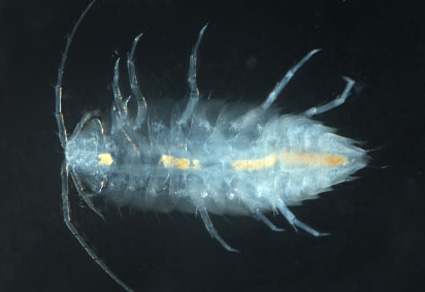Abstract
A new stygobitic calabozoid species, Brasileirinho sergipanus sp. nov., is described. This species is exclusively found in the Toca da Fumaça cave, located within the limestones of the Canudos Geological Formation in Sergipe state, northeastern Brazil. The new species is characterized by several distinctive traits, notably the reduced and simple shape of male pleopod 1, in contrast to the biarticulate, thick lamellar structure with an acute angle observed in its congener, B. cavaticus. This study provides comprehensive biological, ecological, and behavioral insights into the new species, along with details about its conservation status and associated threats.
References
- Bento, D.M., Souza-Silva, M., Vasconcellos, A., Bellini, B.C., Prous, X. & Ferreira, R.L. (2021) Subterranean “oasis” in the Brazilian semiarid region: neglected sources of biodiversity. Biodiversity and Conservation, 30, 3837–3857. https://doi.org/10.1007/s10531-021-02277-6
- Brusca, R.C. & Wilson, G.D.F. (1991) A phylogenetic analysis of the Isopoda with some classificatory recommendations. Memoirs of the Queensland Museum, 31, 143–204.
- Cardoso, G.M., Bento, D.M. & Ferreira, R.L. (2025) Remnants of an ancient world: three new genera and three new species of Calabozoidea isopods from Brazilian semi-arid caves (Crustacea: Isopoda). Tropical Zoology, 38 (1–2), 1–25. https://doi.org/10.4081/tz.2025.180
- Ceballos, G., Ehrlich, P.R., Barnosky, A.D., García, A., Pringle, R.M. & Palmer, T.M. (2015) Accelerated modern human–induced species losses: Entering the sixth mass extinction. Science Advances, 1 (5), 1–5. https://doi.org/10.1126/sciadv.1400253
- Destouni, G., Jaramillo, F. & Prieto, C. (2013) Hydroclimatic shifts driven by human water use for food and energy production. Nature climate change, 3 (3), 213–217. https://doi.org/10.1038/nclimate1719
- Dreyer, H. & Wägele, J.W. (2002) The Scutocoxifera tax. nov. and the information content of nuclear ssu rDNA sequences for reconstruction of isopod phylogeny (Peracarida: Isopoda). Journal of Crustacean Biology, 22 (2), 217–234. https://doi.org/10.1651/0278-0372(2002)022[0217:TSTNAT]2.0.CO;2
- Ferreira, R.L., Martins, R.P. & Prous, X. (2007) Structure of bat guano communities in a dry Brazilian cave. Tropical Zoology, 20 (1), 55–74.
- Ford, D. & Williams, P. (2007) Karst hydrogeology and geomorphology. Wiley, New York, Nw York, 578 pp. https://doi.org/10.1002/9781118684986
- IUCN Standards and Petitions Committee (2022) Guidelines for Using the IUCN Red List Categories and Criteria. Version 15.1. Prepared by the Standards and Petitions Committee. Available from: https://nc.iucnredlist.org/redlist/content/attachment_files/RedListGuidelines.pdf (accessed 30 November 2022)
- Mammola, S., Cardoso, P., Culver, D.C., Deharveng, L., Ferreira, R.L., Fišer, C., Galassi, D.M.P., Griebler, C., Halse, S., Humphreys, W.F., Isaia, M., Malard, F., Martinez, A., Moldovan, O.T., Niemiller, M.L., Pavlek, M., Reboleira, A.S.P.S., Souza-Silva, M., Teeling, E.C., Wynne, J.J. & Zagmajster, M. (2019) Scientists' warning on the conservation of subterranean ecosystems. BioScience, 69 (8), 641–650. https://doi.org/10.1093/biosci/biz064
- Messana, G., Baratti, M. & Benvenuti, D. (2002) Pongycarcinia xiphidiourus n. gen. n. sp., a new Brazilian Calabozoidae (Crustacea, Isopoda). Tropical Zoology, 15, 243–252. https://doi.org/10.1080/03946975.2002.10531178
- Montesanto, G. (2015) A fast GNU method to draw accurate scientific illustrations for taxonomy. Zookeys, 515, 191–206. https://doi.org/10.3897/zookeys.515.9459
- Montesanto, G. (2016) Drawing setae: a GNU way for digital scientific illustrations. Nauplius, 24, 1–6. https://doi.org/10.1590/2358-2936e2016017
- Prevorčnik, S., Ferreira, R.L. & Sket, B. (2012) Brasileirinidae, a new isopod family (Crustacea: Isopoda) from the cave in Bahia (Brazil) with a discussion on its taxonomic position. Zootaxa, 3452 (1), 47–65. https://doi.org/10.11646/zootaxa.3452.1.2
- Silva, A.P.B., Oliveira, I.P.M.R., Bastos-Pereira, R. & Ferreira, R.L. (2018) Are laboratory studies on behavior of troglobitic species always trustful? A case study with an isopod from Brazil. Behavioural Processes, 153, 55–65. https://doi.org/10.1016/j.beproc.2018.05.009
- Tabacaru, I. & Danielopol, D.L. (1999) Contribution à connaissance de la phylogénie des Isopoda (Crustacea). Vie et Millieu, 49 (2/3), 163–176.
- Tabacaru, I. & Giurginca, A. (2020) The Monophyly and the Classification of the Terrestrial Isopods (Crustacea, Isopoda, Oniscidea). Travaux de l`Institut de Spéologie “Émile Racovitza”, 59, 3–23.
- Van Lieshout, S.E.N. (1983) Calabozoidea, a new suborder of stygobiont Isopoda, discovered in Venezuela. Bijdragen tot de Dierkunde, 53 (1), 165–177. https://doi.org/10.1163/26660644-05301013
- Wägele, J.W. (1989) Evolution und phylogenetisches System der Isopoda. Stand der Forschung und neue Erkenntnisse. Zoologica, 140, 1–262.


